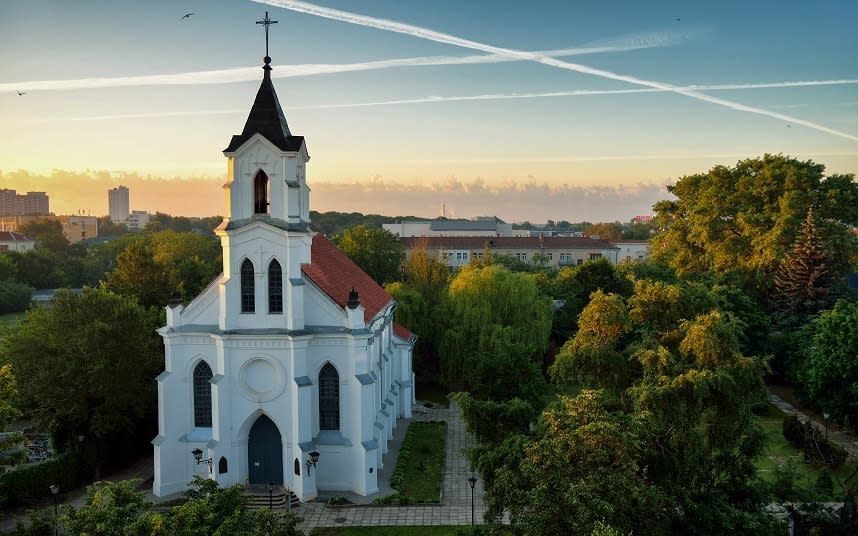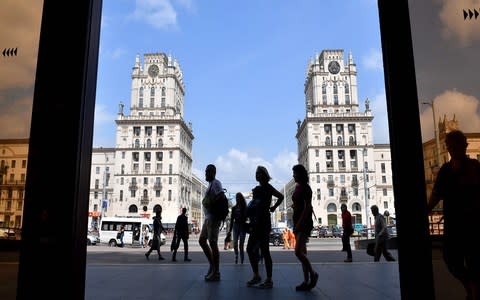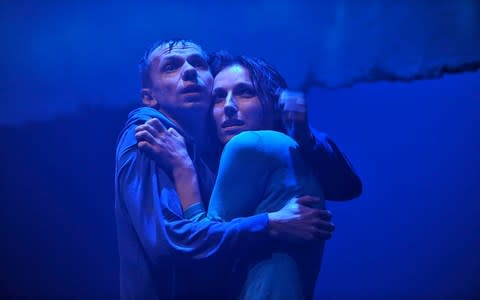Edgelands, episode 5: a psychedelic experience in Minsk

Over the last three months, adventurer Ash Bhardwaj has been travelling Russia's long-contested European border, from the Arctic Circle to Ukraine. In the fifth episode of Edgelands, he visits Minsk - the capital of Belarus - where he has a psychedelic experience with the Belarus Free Theatre before paying a visit to the sobering Khatyn Memorial.
Listen to the fifth episode of Edgelands using the player below. Registered users get early access to each new episode - click here to hear all of the previous episodes.
Viewing this page on mobile? You can lock your phone screen and keep listening.
Edgelands - audio player - 5 of 6
Behind the scenes of episode five
By Ash Bhardwaj
Leaving Minsk train station, I finally discovered why they call Belarus the Last Bastion of Sovietism. The Gates of the City are two identical and imposing buildings, built in the Stalinist Classic style. They soar as squat cubes of diminishing size, stacked on top of each other, creating the sense of a pyramid.
Around the top was the style’s distinctive, unsettling spikiness, but the bottom floor of the left-hand building was occupied by a distinctly un-Soviet KFC.
The Stalinist architecture comes from the rebuilding of Minsk after the Second World War. The total effect is impressively grand and coordinated, with broad avenues, and squares laid out in front of government building. But in other parts of the town, architecture from the Soviet era is being reused in ways that it designers could never have imagined.

Octobrieska Street is home to the national vodka factory. Outside the front door is a board titled “Glorious Workers”, with photos of employees who have won “worker of the month" awards. But on the other side of the street is a vast, abandoned, red-brick factory. And it’s covered in colourful, South American graffiti.
The area is known colloquially as Brazilian Street, because it is the site of an annual Carnival, backed by the Brazilian embassy. Nobody I met could explain this incongruous connection, but it didn’t really matter. It seems to have become the lightning rod for creative expression, seemingly out of touch with the rest of the city.
“This is all very new to Minsk,” says Olga, a student who has lived in both Russia and Belarus, “Three or four yeas ago, I didn’t want to stay here. Everything was grey and boring, and the government were scared of people expressing themselves. Now there are all sorts of art projects, and it feels so exciting and full of opportunity.”
Meet Ash Bhardwaj | Edgelands correspondent
The factory is now an art gallery, with the sort of provocative works that Tracey Emin would approve of. Tram tracks run down the road and, on the sunny side of the street, an old tram depot has been converted into cafes and bars. They sell IPAs to bearded, tattooed men on fixie bikes, whilst girls in dungarees sip flat whites in the courtyard. You don’t even need to squint to think you’re in Berlin.
Opposite, in Bar Huligan, DJ Vadim was setting up for his evening set.
“We are strictly vinyl,” he says, “And only push the music that we love, like Northern Soul, house and old skool. This scene is new here, so we have a duty to educate people. We don’t have a lot of quality clubs in Belarus, and those that exist play commercial and EDM (electronic dance music). But in bars like this, you can find local DJs building a new culture.”
Dance music is gently challenging conservative culture, but the Belarus Free Theatre (BFT) take a more direct approach.
“To perform in Belarus,” says Tanya, a local journalist. “You have to get your play signed off by the Ministry of Culture, so anything subversive can’t be officially performed. But there is a tradition in Soviet countries: that when the media can’t hold power to account, theatre takes its place.”

Some of BFT’s performances explore taboo subjects like suicide, substance abuse and homosexuality, challenging the narrative of President Alexander Lukashenko (whose regime denies that such things exist). BFT performances have been raided by the police, leading to temporary detention for the audience and even prison time for company members.
To get around this censorship, many BFT rehearsals are done abroad, and performances are done at short notice in people’s flats, studios or even out in the forest. We were told to be outside a petrol station in the city suburbs at a certain time, to meet a guide from the company.
We were led down streets to an apparent building site, and entered a low room. The ensuing contemporary performance was a surreal experience, and the most amazing displays of athleticism I have ever seen. Three male dancers anguished their way through allegories of birth and madness, whilst one struggled to remove his hand from a jar. When it finished, I felt like I had returned from a dream. I asked Tanya if there was any allegory to it.
“Perhaps the struggles of the jar and rebirth suggest throwing off oppression,” she said. “But the key is what you felt. It was an almost hallucinogenic experience, and you will not forget that. You are somehow changed by it.
“Most of the directors and writers in Belarus are appointed by the government. They are conservative and don’t do anything innovative. So, even if this performance isn’t commenting directly on society, it is changing the people who have seen it.”
Minsk’s architecture might be a monument to Sovietism, but in the city’s art and culture, the last bastion is crumbling.
How to get there
To learn more about Belarus Free Theatre, visit belarusfreetheatre.com.
Baltic Holidays (balticholidays.com) can create bespoke tours to Belarus and neighbouring countries.
Edgelands - promo embed - end of article

